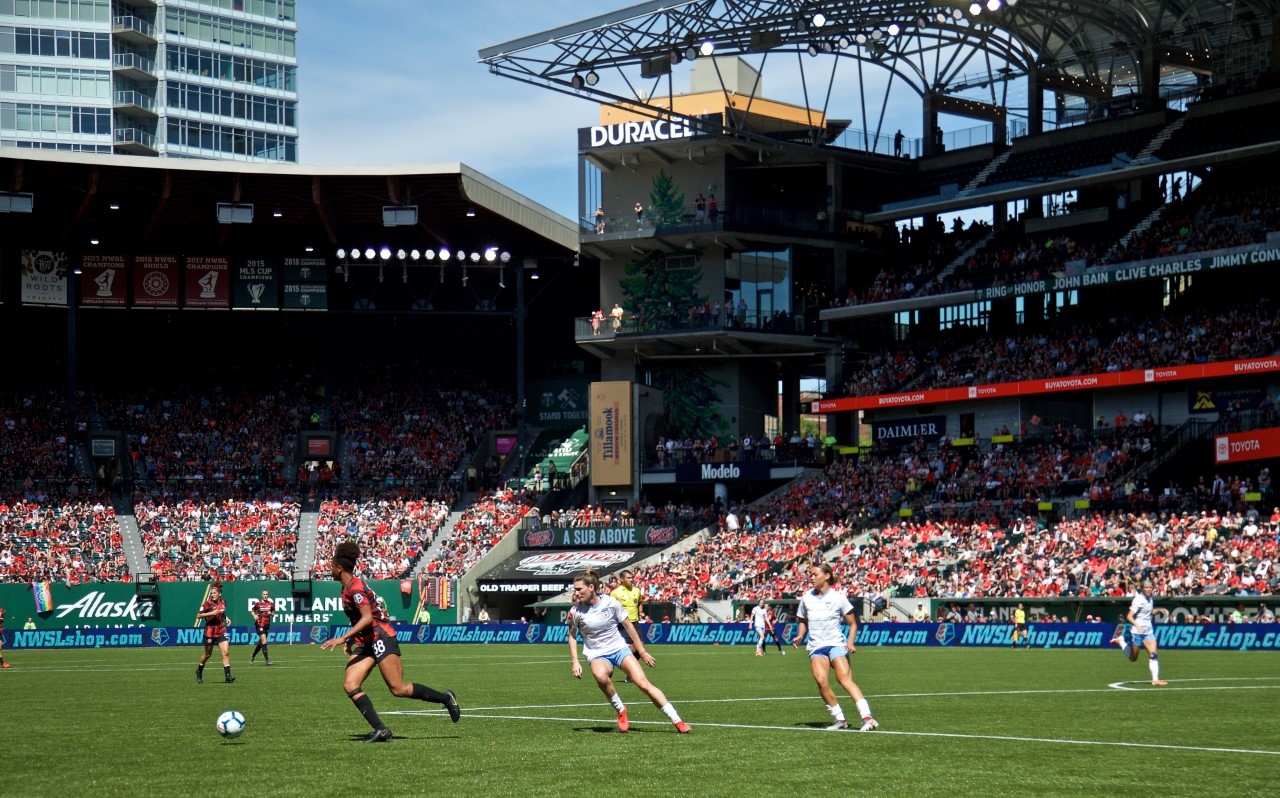The city’s women’s soccer team has seen an uptick in attendance since the 2019 FIFA Women’s World Cup. Is it a temporary boost or laying the foundations for things to come?
When it comes to changing the face of a sport forever, few athletes are more outstanding than the 2019 U.S women’s World Cup team.
“Boys are wearing U.S. Women’s National Team jerseys, and that feels like progress,” wrote Chicago Tribune columnist Heidi Stevens in an article which suggested, anecdotally, that the Women’s World Cup team had gotten people more interested in women’s soccer than ever before.
If the U.S.’s victory in the 2019 FIFA Women’s World Cup had indeed caused a ripple effect in women’s soccer, its stands to reason that the Portland Thorns, the city’s women’s soccer team, which holds the best record and highest attendance in U.S. women’s soccer, would feel the reverberations as much, if not more, than anyone.
Four players from the Thorns represented the U.S. in the 2019 World Cup: midfielders Tobin Heath and Lindsey Horan, defender Emily Sonnett and goalkeeper Adrianna Franch. Five other Thorns players attended the World Cup representing other countries.
Mike Golub, president of business for the Portland Thorns and Timbers, the men’s soccer team, says he has seen increased interest in Thorns soccer following the World Cup victory, even more so than after the 2015 championship.
“The excitement, attention and buzz that happened following the [World Cup final] was unprecedented,” he says. “It has absolutely manifested in support for soccer clubs.”
Still, for all the buzz surrounding the invigoration of women’s soccer, prickly questions still remain. Indeed, boys wearing women’s jerseys wouldn’t be viewed as progress if they had been doing it regularly before now.
Part of the issue is that the NWSL is still young, as far as sports leauges are concerned. From 2013 to 2016 the league only played one full season, due in no small part to the 2015 Women’s World Cup and 2016 Olympic Games, respectivley. But things have changed since then. The league continued to host matches after players departed for the 2019 World Cup, a testement to the League’s mounting popularity. The other issue is visibility. After a brief arrangement with television sports channel ESPN, the league signed a broadcasting arrangement with television network A&E to show weekly games on the Lifetime channel.
After the World Cup victory, however, the league has made its return to the national sports network.
Following the World Cup victory, the league has ended its partnership with A&E and signed an agreement with ESPN to televise 14 league matches during the 2019 season. The agreement states that eight matches will air on ESPNEWS, and the remaining six, including the two semifinals and the championship, will air on ESPN2.
The very first broadcast was on July 14 when the Portland Thorns faced Orlando Pride, live from Portland’s Providence Park. The Thorns prevailed 4-3.
“With the success of the Women’s World Cup, we knew we had to make space and put them on our air,” says Mac Nwulu, associate director of communications at ESPN.
“Our survival depends on bringing new people to sports. With the amount of younger women starting to like soccer and watching soccer, we want them to be watching on ESPN.”
Nwulu says that despite the fact that so much soccer is being played worldwide, the growing popularity of women’s soccer, at least in the U.S., is starting to give women’s league games preeminence. “The [World Cup victory] has made the league very popular, and we are in the business of growing our audience. It’s what people want. Right now, it is top of mind. They are selling out stadiums.”
While no one can predict the future, the league itself is trying to ensure it has as bright a future as possible. It has stayed strong in part because of the support of the United States Soccer Federation, which poured $18 million into promotional operations, as well as subsidized player salaries.
The deal with ESPN only broadcasts 14 games out of 108. This means that most fans are still going to be streaming their teams’ matches through apps, such as Yahoo! Sports and NWSL’s streaming app.
Like many professional soccer teams, the bulk of Thorns revenue comes from ticket sales, so the World Cup victory certainly translated into measurable financial gain. For Golub, however, the spikes in interest create opportunities, but aren’t essential for the Thorns’s success.
Even when Thorns players were overseas to participate in the FIFA Women’s World Cup, attendance was still high (between 18,000 and 19,000 thousand fans) but afterwards the numbers climbed up to 20,000, with some games selling out completely. For reference, Providence Park soccer stadium in Portland can hold more than 25,000 attendees.
“Is it nice to have these spikes? Absolutely. But for us it’s about cultivating lifelong Thorns fans,” says Golub. “We do that by exposing them to the experience on the field. Winning championships helps. Having great athletes who are great people helps. Having a great experience at the stadium helps. It all builds a rock-solid foundation so we can continue to be the best-attended women’s sports team in the world.”
The Thorns aren’t the only team to feel an attendance boost. League attendance increased 18% overall after the World Cup victory.
Though ticket sales are the main source of revenue for the Thorns, advertising partnerships are a close second.
Support from longtime partners, such as Key Bank, Providence and Widmer, as well as new partners like Toyota, have served to elevate both soccer clubs. Two-thirds of Thorns advertisers are Timbers partners as well.
“It’s a pretty compelling proposition for [advertisers] when you can average 20,000 fans a game, and athletes who are so involved in community programs,” says Golub.
Advertising for soccer presents unique challenges. The long halves are played all the way through, making traditional TV commercials impossible. The league has found ways to address these advertising challenges during the games, such as having “clock wrap,” in which business logos can be displayed around the time box.
The stadium also sells ad space on LED boards, which cameras sweep over regularly as players pass up and down the field. While these forms of advertising don’t leave room for the traditional 30-second commercial spot, they do have certain advantages.
“They’re DVR-proof,” says Golub.
Still, the difficulty of advertising, as well as perceptions that women’s sports won’t garner the same viewership as male sports, led some business partners to be skittish of the club during its formation. Those fears were laid to rest by the Thorns’ success.
“When we first started the club in 2013, our partners were supportive, but the jury was still out for many of them. The last two leagues only lasted three years, so they had questions. Now those questions have been put to bed, and our Timbers partners have come in big time,” says Golub.
“It’s a pretty compelling proposition for [advertisers] when you can average 20,000 fans a game, and athletes who are so involved in community programs,” he says. “The World Cup this year didn’t manifest in any new deals, but we’ve been able to grow our partnerships every year. I think next year will be no different.”
To subscribe to Oregon Business, click here.







